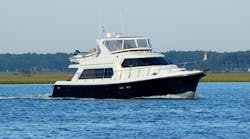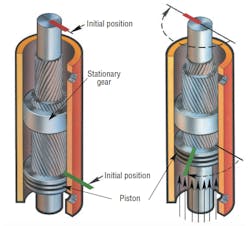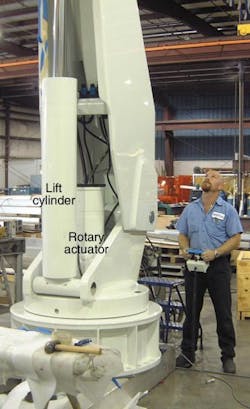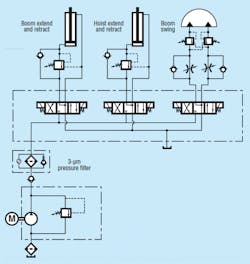Most of us can only dream of owning or even spending any appreciable time on a luxury yacht. One might imagine that no expense is spared to make these magnificent vessels as comfortable and luxurious as possible. But comfort and luxury are words not generally associated with hydraulics. Still, for those who build equipment used on luxury yachts, comfort and luxury are the order of the day — even if the equipment relies heavily on hydraulics.
That is the challenge facing designers at Nautical Structures, Largo, Fla. Nautical Structures designs and builds accessories for yachts, such as the davit shown at right. A davit is a specialty type of deck crane that pivots over the side of the yacht and is used primarily for hoisting a boat into or out of the water and onto the deck of the yacht. This smaller boat, or tender, often acts as a shuttle between the yacht and nearby destinations.
Nautical Structures also builds articulated gangplanks, passerelles, deck and overhead beam cranes, and custom structures — all used on luxury yachts. The gangplanks use hydraulics to extend a moveable structure from within the yacht to a dock or other area where passengers will board or disembark the craft. When the gangplank is not needed, hydraulic actuators pull it back into the hull of the yacht, where it is completely hidden from view.
According to Rick Thomas, vice president at Nautical Structures, designing hydraulic systems to operate davits calls for creativity and unconventional techniques. For example, davits must be designed to look as attractive — and often luxurious — as possible. But sometimes attractive and luxurious isn’t good enough — invisible is. He explains, “Obviously, all areas normally accessed by passengers of a luxury yacht must be as comfortable and attractive as possible. But areas and equipment not normally seen or used by passengers must meet the same criteria. This goes for davits as well. Most of the time, we supply the builder of the boat with a davit painted to high quality, high gloss finish. Rather than using a chrome-plated carbon steel piston rod, we often specify a rod made of SAE 316 stainless steel. In some cases, we’ve made the entire boom cylinder — rod, barrel, end caps, and bolts — of stainless steel polished to a mirror-like finish.
“A davit such as this looks great perched over a tender mounted on the deck. But when the tender has been deployed into the water, some owners want the davit to disappear. In this case, hydraulic actuators retract the majority of the davit down into the deck, so that only a small portion is exposed. It’s also safer because there is no exposed boom for passengers or crew to strike their heads on.”
Conventional won’t cut it
Noise, or lack of it, is another important consideration. Not surprisingly, then, the davit’s hydraulic power unit is designed for quiet operation and contained within a noise suppressing enclosure. But the winch drive for the davit is quite a departure from convention. Normally, a hydraulic winch uses a motor to rotate a drum that winds or unwinds steel cable around a spool for lifting or lowering a load. Thomas points out that this method produces a undesirable noise whenever the hydraulic motor operates. “A hydraulic motor makes a rather distinct sound that is somewhat high-pitched. It can even be loud enough to impose on nearby conversation and can be heard throughout the yacht. In the environment of a luxury yacht, this noise is not only unacceptable, considering that the davit may have to be deployed when all is quiet and passengers are sleeping.”
Instead of using the conventional hydraulic motor to power the davit, Nautical Structures uses a hydraulic cylinder. Although the cylinder is not completely silent, the slight noise it does emit is a smooth, gentle whisper or hiss — not the whine of a motor that changes pitch relative to speed.
“But we don’t use a cylinder with a 20-ft stroke to pay the cable in and out,” reveals Thomas. “Instead, the cylinder typically has only a 4- to 5-ft stroke, and a compound block-and-tackle arrangement multiplies the travel to 25 ft or what ever is needed. Theoretically, we size the cylinder to produce roughly six or seven times the force needed to lift the load, then specify a block-and-tackle arrangement that multiplies the stroke by six or seven, and decreases the force by six or seven times.” Thomas adds that frictional loss between the cable, sheaves, and bearings amounts to about 25%. Plus, they provide about 15% extra capacity to allow for cargo and other additional weight on the tender when it is hoisted. If this allowance is exceeded, the davit will stall, thus providing built-in safety.
An additional benefit to this setup is longer cable life. Thomas explains, “With a conventional winch, the cable must have a mechanical stop fixed to its end to prevent the cable from being pulled completely into the winch. The problem is, when the winch draws the cable in, it undergoes a sudden jolt when the end stop reaches the inlet of the winch. This can transmit a substantial shock load to the cable, thereby shortening its life. This effect is similar to holding a string between your hands and pulling. You may not be able to break the string, even if you pull with all your strength. But if you let the string go slack, then suddenly jerk your hands apart, the string will snap.
“With our setup, the cylinder can only travel a predetermined distance, so a mechanical stop is not needed. Cushions at both ends of the cylinder ensure smooth starting and stopping at both limits of travel. So our hydraulic davit and winch drives are not only quieter than anyone else’s, they are more reliable and safer.”
Another challenge was to provide a means to pivot the davit boom once it lifts the tender from the deck. This motion requires pivoting the main arm perhaps 180° or more until it has cleared the deck and can lower the boat into the water. Thomas continues, “For the pivot drive, we could’ve used a hydraulic cylinder, but this arrangement would have limited us to only about 90°of travel. Plus, the assembly would not have been visually appealing. To gain nearly full pivot rotation, we could’ve used a hydraulic motor and a slew ring to make a conventional swing drive. But, again, the hydraulic motor would have been too noisy.”
What Nautical Structures chose instead is a helical rotary actuator with integral bearings, manufactured by Helac Corp., Enumclaw, Wash. Tom Krause, a spokesman for Helac, explains that based on output torque and rotation required, this is the most compact of any rotary actuator design available. Furthermore, he says its integral bearings produce clean, compact assemblies for a wide variety of applications, including construction and mining equipment, refuse cart dumpers — anywhere compact size, high torque, and wide angle of rotation are needed.
Referring to Figure 2, Krause explains that the actuator is composed of three basic parts: the central through shaft, the annular piston, and the housing. Helical gear teeth on the shaft mesh with matching teeth on the ID of the piston; a second set of helical teeth of opposite hand on the OD of the piston engage the housing’s integral ring gear. (See illustration for explanation of operation).
The double helix gear design works to compound shaft rotation: the rotation of the shaft is almost twice that of the piston. The result is a slender, compact, symmetrical design that generates tremendous torque, is very resilient to shock loads, and has none of the housing protrusions found in alternative designs.
Aside from the inherent compact size of the actuator, Krause adds that integral bearings and large drilled-and-tapped mounting holes make it easy to design the actuator into a structure and simplify installation. “Installation typically involves isolating the actuator from external loads by positioning it independent of the slew bearing. This prevents transmitting side loads to the actuator, so its bearings only need to support the torque load. This helps the davit operate efficiently even in rough seas.”
Control for safety and precision
For safety’s sake, the davit will not operate unless the control console is attached. Once a 6-m control cable is connected to the davit, an interlock closes a switch, which allows the hydraulic power unit (HPU) to be energized. Thomas says a typical HPU delivers up to 6 gpm of fluid filtered to 3µm at a pressures to 3,000 psi.
“The operator energizes the HPU through the control console and controls up to four axes of motion through a pair of P-Q Controls joysticks,” explains Thomas. “The joysticks communicate with size D03 Eaton-Vickers proportional valves through valve driver cards. from P-Q Controls.” Smaller cranes, as represented in Figure 4, use standard directional, rather than proportional valves, unless proportional control is specified by the customer (boat builder). The four axes include three cylinder motions — boom extend-retract, boom up-down, winch up-down — and the boom pivot motion generated by the rotary actuator.
Hydraulics answers the call
No single design challenge in this application proved especially difficult to meet. As with most hydraulic systems operating in a marine environment, exposure to sunlight, a wide range of ambient temperatures, harsh environmental conditions, and potential contamination and corrosion from salt water were addressed by strategic design and material specification techniques. What demanded real creativity, though, was to design a system that if seen, would look great. And if heard, would be little more than a whisper.





